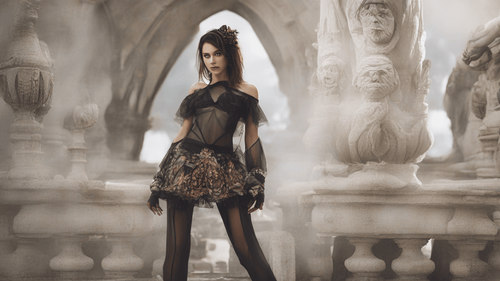
Introduction: Embracing the Future of AI-Powered Image Generation
In this age of technological marvels, artificial intelligence (AI) continues to push the boundaries of human ingenuity. Among its many incredible applications, AI text to image stands out as a groundbreaking technology that bridges the gap between language and visual content. This revolutionary capability allows AI systems to transform textual descriptions into astonishingly realistic images, fostering endless creative possibilities.
Understanding AI Text to Image: The Magic Unfolded
Imagine a world where the power of words can effortlessly conjure vivid and lifelike visuals. AI text to image is precisely that magic – a process where AI algorithms convert textual input into visually captivating imagery. It employs advanced natural language processing (NLP) and computer vision techniques to interpret text and generate images that align with the provided descriptions. The results are astonishingly accurate and often indistinguishable from human-created artwork.
How AI Text to Image Works: Delving into the Art of Creation
The process of AI text to image generation involves several intricate steps:
Step 1: Data Collection and Preprocessing
To create remarkable visual representations, AI systems require vast amounts of data. This step involves collecting and curating diverse datasets that comprise textual descriptions and corresponding images. The data is then preprocessed to extract relevant features and establish connections between words and visual elements.
Step 2: Training the AI Model
Next, the AI model undergoes intensive training using the prepared datasets. During this phase, the model learns to understand language patterns, grasp contextual relationships, and interpret visual cues. Deep learning techniques, such as Generative Adversarial Networks (GANs) and Transformer models, are often employed to enhance the system's creativity and image generation capabilities.
Step 3: Text Embedding and Image Synthesis
As the AI model becomes proficient, it embeds the textual input into a latent space representation, transforming words into numerical vectors. Using these embeddings, the model then synthesizes images by combining relevant visual elements, colors, textures, and compositions to produce visually appealing results.
Step 4: Refinement and Iteration
Creating impeccable artwork demands refinement and iteration. The AI-generated images are subjected to evaluations and fine-tuning to enhance their quality and realism. This iterative process ensures that the images align more accurately with the given textual descriptions.
AI Text to Image Applications: Revolutionizing Industries
The applications of AI text to image technology extend far beyond the realm of artistry. Its versatility and practicality make it a transformative force across various industries:
1. Digital Content Creation: Redefining Visual Storytelling
In the realm of digital content creation, AI text to image empowers creators and marketers with the ability to illustrate stories and concepts quickly. Whether designing book covers, social media graphics, or website banners, AI-generated images streamline the creative process, saving both time and resources.
2. E-Commerce: Elevating Product Visualization
Online shopping becomes more captivating and interactive with AI-generated product images. E-commerce platforms can now offer customers realistic depictions of products based on textual descriptions, aiding purchase decisions and reducing return rates.
3. Architectural Visualization: Bringing Blueprints to Life
Architects and designers benefit from AI text to image by visualizing architectural plans. Descriptions of buildings, interiors, and landscapes can be transformed into lifelike 3D renderings, enabling clients to envision projects with unparalleled clarity.
4. Gaming and Entertainment: Enriching Immersive Experiences
The gaming and entertainment industries thrive on visual appeal. AI text to image contributes by generating breathtaking landscapes, characters, and assets, making virtual worlds more immersive and captivating than ever before.
5. Accessibility: Enabling Visual Content for All
AI-generated images open new avenues for accessible content. Visually impaired individuals can now experience visual elements in written content, fostering inclusivity and equal access to information.
FAQs: Demystifying the Magic of AI Text to Image
How Accurate are AI-Generated Images?
AI-generated images have made remarkable strides in accuracy. While they may not always achieve perfection, the quality continues to improve through advanced algorithms and refined training processes.
Are AI Text to Image Systems Ethical?
As with any AI technology, ethical considerations are crucial. Transparency in AI-generated content and the responsible use of AI systems are essential to ensure ethical guidelines are upheld.
Can AI Text to Image Replace Human Creativity?
AI text to image is a powerful tool, but it cannot entirely replace human creativity and artistic expression. It serves as a valuable aid to complement human ingenuity rather than supplant it.
What Challenges Does AI Text to Image Face?
AI text to image technology still grapples with certain challenges, including occasional inaccuracies in image synthesis and potential biases within training data. Ongoing research aims to address and mitigate these issues.
Is AI Text to Image Only for Experts?
AI text to image tools are designed to be user-friendly, enabling individuals with limited design experience to create compelling visual content effortlessly.
Can AI Text to Image Impact Copyright and Plagiarism?
AI-generated images raise concerns about copyright and plagiarism. To address this, proper attribution and copyright guidelines must be followed when using AI-generated content.
Conclusion: Unlocking the Boundless Creativity of AI Text to Image
AI text to image exemplifies the extraordinary potential of artificial intelligence to transform our creative landscape. From simplifying content creation to revolutionizing industries, this technology holds the key to unlocking limitless visual creativity. By embracing AI text to image responsibly and ethically, we embark on a journey where words become the brushstrokes of imagination, painting a world of beauty and innovation.